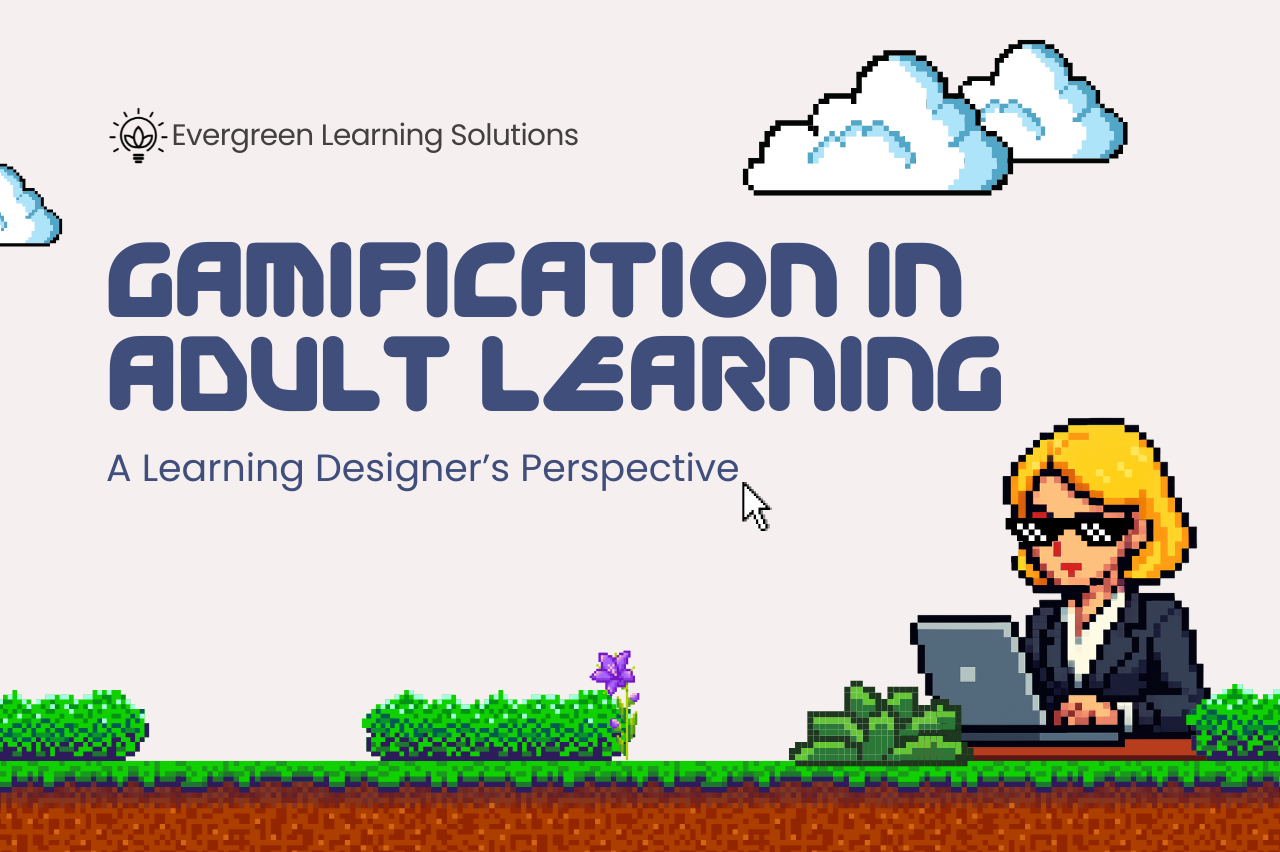My Big Aha! Moment
Picture this: I’m at a conference, sitting in a room with about 200 teachers. A presenter confidently declares:
“Don’t use digital games to teach children. It doesn’t work!”
No proof. No data. Just a bold statement.
My immediate thought? Hmm… I’m not so sure about that. As a learning designer and teacher, I’ve seen how powerful play and interactivity can be – not just for students, but for adults too. Maybe full-blown digital games aren’t always the answer, but what about using parts of what makes games so motivating? That moment sparked my deep dive into the research on gamification.
What Is Gamification?
You might already know that playing games can be great for learning, but “gamification” is a bit more specific. It’s about taking game-like elements things like:
✔️ Points and badges
✔️ Levels or progress bars
✔️ Leaderboards and challenges
✔️ Team play or collaboration
And weaving them into non-game situations like courses, workshops, or workplace training.
It’s not about turning everything into a video game. It’s about borrowing the most effective elements from games to make learning more engaging, rewarding, and fun.

How Gamification Can Supercharge Learning
When you’re playing a game, you’re constantly making decisions, getting feedback, and adapting your approach. That’s exactly what we want in learning.
Research shows that, when done well, gamification can:
- Boost motivation and focus
- Improve problem-solving skills
- Encourage persistence through challenges
- Help learners feel a sense of progress and achievement
Learning in Our Digital World:
The Connectivist Lens
The learning theory called Connectivism sees learning as something that happens in networks — between people, technology, and communities.
Gamification fits neatly into this idea. It can:
- Support collaboration through team challenges
- Create community via peer feedback
- Encourage shared progress tracking
Of course, there are challenges too – not everyone loves games, and simply adding random points to dry content won’t make it engaging.

Best Practices and Research Insights
Studies generally show gamification can improve learning outcomes, but results vary. The key? Purposeful design.
It works best when:
- Goals are clear
- Recognition (such as badges) is meaningful
- Feedback is regular and constructive
Interestingly, some research even shows introverts often thrive in gamified environments, sometimes outperforming extroverts in accuracy, consistency, and point collection. Why? Because gamification offers clear goals, instant feedback, and the opportunity to progress at your own pace – all things that can resonate deeply with introverted learners.
Practical Ways to Add Gamification –
Without a Huge Budget
You don’t need a high-end Learning Management System (LMS) or a long list of paid plugins and subscriptions to add gamification to your learning design. You can start with free or low-cost tools you already have.
Here are some easy, low-cost options:
- Create Your Own Badges in Canva
- Design badges for milestones (e.g., Module 1 Master, Collaboration Pro).
- Upload them to your LMS or email them directly to learners.
- Use ChatGPT or Canva AI to Generate Code for Simple Game Elements
- Ask ChatGPT to create HTML/JavaScript for a progress bar, leaderboard, or quiz.
- Embed these into your LMS, website, or even a shared Google Site.
- If using Canva AI – publish as a sharable website or paste into other Canva designs and create a public link.
- Repurpose Everyday Tools
- Use Google Forms for “choose your own adventure” learning paths.
- Add points or instant feedback for interactivity.
- Build Leaderboards in Google Sheets
- Share a live leaderboard.
- Highlight top performers to encourage friendly competition.
Start small, see what works, and adapt for your learners.

My Takeaway
Reflecting on the research and my own experiences – I’m convinced gamification can be a powerful tool for adult learning. Done right, it can transform “just another course” into something motivating, memorable, and even fun.
And you know what? It’s even better knowing there’s solid research out there to back it up!
References:
Adams, S. P., & Du Preez, R. (2022). Supporting Student Engagement Through the Gamification of Learning Activities: A Design-Based Research Approach. Technology, Knowledge and Learning, 27(1), 119–138.
Bai, S., Hew, K. F., & Huang, B. (2020). Does gamification improve student learning outcome? Evidence from a meta-analysis and synthesis of qualitative data in educational contexts. Educational Research Review, 30, 100322.
Barber, C. S. (2021). When Students are Players: Toward a Theory of Student-Centric Edu-Gamification Systems. Journal of Information Systems Education, 32(1), 53–65.
Borrás-Gené, O., Martínez-Núñez, M., & Martín-Fernández, L. (2019). Enhancing fun through gamification to improve engagement in MOOC. Informatics (Basel), 6(3), 28.
Haas, L. & Tussey, J. (2022). Equity and Engagement Through Digital Storytelling and Game-Based Learning. In I. Management Association (Ed.), Research Anthology on Developments in Gamification and Game-Based Learning (pp. 1451-1472). IGI Global.
Sankey, M. D., Huijser, H., & Fitzgerald, R. (Eds.). (2023). Technology-Enhanced Learning and the Virtual University (1st ed.). Springer Nature.
Smiderle, R., Rigo, S. J., Marques, L. B., Peçanha de Miranda Coelho, J. A., & Jaques, P. A. (2020). The impact of gamification on students’ learning, engagement and behavior based on their personality traits. Smart Learning Environments, 7(1), 1–11.
Smith, K., & Abrams, S. S. (2019). Gamification and accessibility. Campus-Wide Information Systems, 36(2), 104–123.
Upadhyaya, D., & Garg, A. (2019). Leveraging on gamification and learning analytics for improved student learning. 2019 International Conference on Computing, Power and Communication Technologies (GUCON) (pp. 132–138).
